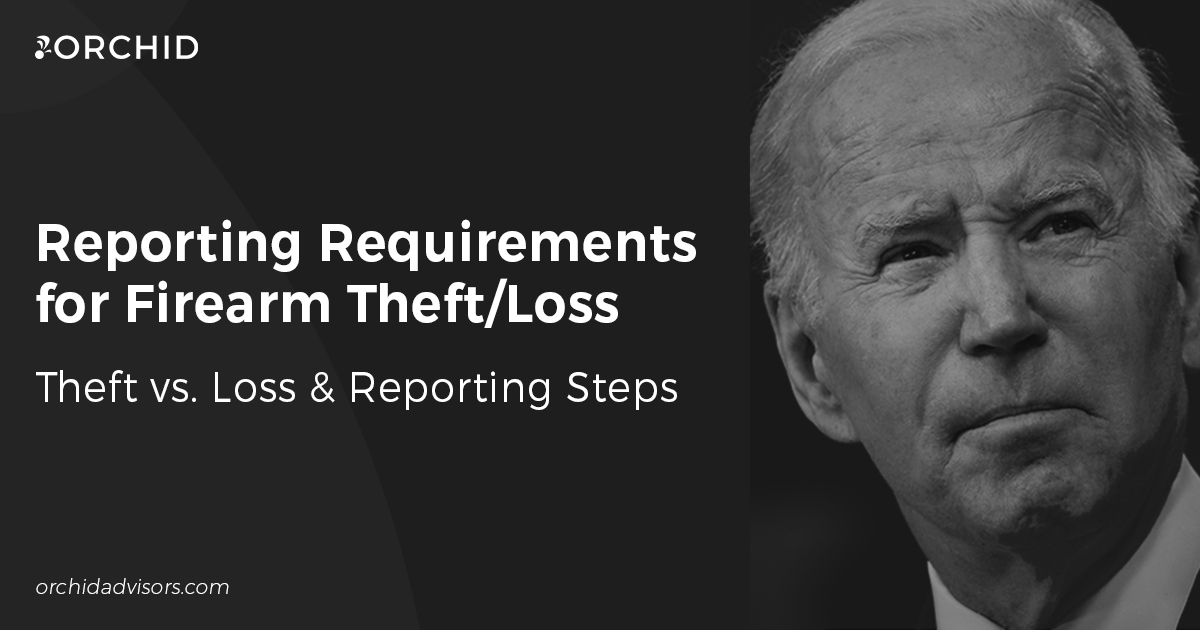Every day, tens of thousands of firearms are manufactured, shipped, acquired, sold, transferred, and taken in for gunsmith work, but occasionally, some are lost or stolen. Though careful recordkeeping can prevent firearms from being lost, theft can be much more difficult to prevent.
In 2021, over 10,000 firearms were reported stolen or lost. However, under the Biden administration’s new zero tolerance policy, even just one misplaced or stolen gun is too many. Worse, failing to report a firearm as lost or stolen within 48 hours of discovering the theft/loss – as required by federal regulation – could be considered a willful violation and grounds for revocation.
Between 2016-2020, ATF cited nearly 500 instances of such failures.
Firearm Loss vs. Theft
The term “loss” refers to firearms in which an FFL has a record of acquiring the firearm into their inventory but later cannot account for its disposition, while “theft” refers to firearms unlawfully taken via burglary, robbery or larceny.
Loss is also commonly referred to as “missing” from inventory. Missing firearms are generally discovered by ATF during a compliance inspection, but they can also be discovered by the FFL during an internal audit.
Burglary involves breaking into a structure to commit a crime, such as stealing firearms, whereas robbery refers to taking property from a person through force or the threat of force. Larceny is the taking of property without breaking into a structure or the threat/use of force to do so.
While firearms are typically lost or stolen from a licensee’s place of business, it’s important to note firearm theft/loss can also occur during order fulfillment and in transit between FFLs.
Theft/Loss Regulations
Reporting
ATF regulation states FFLs shall report the theft or loss of a firearm from the licensee’s inventory within 48 hours after the theft or loss is discovered.
Each licensee shall report the firearm theft/loss by telephoning ATF at 1 (888) 930-9275 and by preparing and submitting an FFL Theft/Loss Report (ATF Form 3310.11) to the ATF. In addition, theft/loss should also be reported to the appropriate local law enforcement agency of either the licensee’s location or where the theft or loss occurred.
Recordkeeping
In 2016, ATF amended the regulation to clarify that when a licensee has a loss incident involving an NFA weapon, the loss must also be reported on a Form 3310.11. The original report shall be retained by the licensee as part of the licensee’s required records.
FFLs must then reflect the firearm theft/loss as a disposition entry in the A&D bound book no later than seven (7) days following discovery of the theft or loss. The disposition entry shall record whether the incident is a theft or loss, the ATF-Issued Incident Number, and the Incident Number provided by the local law enforcement agency.
When a firearm is stolen or lost in transit on a common or contract carrier, it is considered stolen or lost from the transferor/sender licensee’s inventory for reporting purposes. Therefore, the transferor/sender of the stolen or lost firearm shall report the theft/loss of the firearm within 48 hours after the transferor/sender discovers the theft or loss.
Licensees who later discover a lost or stolen firearm shall advise ATF that the firearm has been located and re-enter the firearm in their Bound Book as an acquisition or disposition entry.
How to Report Firearm Theft/Loss
FFLs should take the following steps to report a firearm theft or loss within 48 hours of discovery:
- Contact local law enforcement to report the theft/loss.
- Contact ATF’s Stolen Firearms Program Manager at 1 (888) 930-9275.
- Complete an FFL Theft/Loss Report (ATF Form 3310.11) and submit via listed mail, email or fax. A separate form is required for each theft/loss incident. Reports should be maintained as part of licensee’s permanent records.
- Record a firearm disposition within 7 days. Dispositions should indicate whether the incident is a theft or loss, the ATF Issued Incident Number, and the incident number provided by the local law enforcement agency.
Orchid Zero Tolerance Protection
At Orchid, our team of operations, technology and legal professionals understand the risks of today’s firearm businesses. For over a decade, we’ve worked with FFLs big and small to implement leading compliance best practices and software solutions to eliminate violations and protect licenses from revocation.
Continuing our Zero Tolerance Protection series, we’ll share our expertise and experience in proactive compliance as we look closer at Biden’s policy and its impact on the firearms industry, review how to avoid and correct violations, and suggest ways to protect your FFL from the risk of revocation. Next, we’ll discuss failures to allow ATF inspection and provide access to serialized inventory.
In the meantime, learn more about a Zero Tolerance Rapid Assessment of prior ATF Reports of Violations, your A&D Bound Book, and recent ATF Forms 4473. We also encourage you to watch our webinar on ATF zero tolerance enforcement, schedule an in-person or remote mock ATF inspection, and implement leading compliance software in your retail FFL. Contact Orchid today to protect your FFL from a zero tolerance revocation.








0 Comments